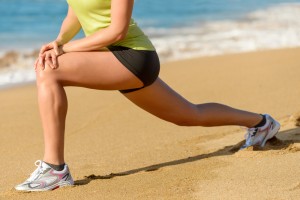Posted on August 15, 2016 by Jenny Cromack
Do you suffer from chronic or returning hip, knee, or ankle pain when running? Often these “overuse” or gradual onset injuries are related to imbalances in muscular strength and soft tissue flexibility. This article will offer some prehabilitation/rehabilitation exercises to help strengthen commonly weak muscles and “iron out” those tight tissues. As a runner it is essential that you focus on including regular strength work into your weekly regime, so try these exercises for leg strengthening for runners and see what a difference it makes to your training.
Before we begin any warm ups or activity it is a good idea to get our soft tissues in an optimal state so we can get the most out of our exercises. So following is a series of stretching and tissue mobilisation exercises for key areas in runners and those with nagging injuries to the hip or knee. The exercises that follow are only examples of commonly problematic areas and your warm up should include all muscle groups.
Stretching and Mobilisation
The hip flexors and Iliotibial Band (ITB) are often shortened and tight in regular runners. These tissues become tight and can the pull upon the hip and knee joints. With this abnormal pull they can often become misaligned which can create unwanted, sub-optimal, stress through the joint and surrounding tissues; this often results in the gradual onset of pain. The following stretching progressions will help loosen these tissues ready to work into the strengthening exercises.
1. Hip Flexors
Static Stretch – Kneeling Hip Flexor Stretch – 1 x 30 seconds Each Leg
Dynamic Stretch – Reverse Lunge Stretch – 2 x 6 Each Leg
2. Iliotibial Band (ITB)
Static Stretch – Side Lying ITB Stretch – 1 x 30 seconds Each Leg
Dynamic Stretch – Side Lunge with C Stretch – 2 x 8 Each Leg
Strengthening
The following exercises will look to improve the strength and muscular endurance of key areas for stabilisng and supporting the hips and knees; Glutes (medius, minimus, and maximus), and the Quadriceps (especially the Vastus Medialis Obliquus- VMO). Optimal function of these muscles will ensure the correct movement patterns and tracking of the hips and knees during running, this minimising unnecessary stress through these joints and associate soft tissues.
Body Weight Exercises
A1. Clams – 2 x 15 Each Leg
A2. Side Lying Leg Raise – 2 x 15 Each Leg
B1. Glute Bridges – 3 x 15
C1. Single Leg VMO Mini Squats – 3 x 12 Each Leg
Equipped Exercises
A1. Banded X-Walks – 3 x 10 Steps Each Side
B1. Weighted Hip Thrusts – 3 x 12
C1. Goblet Cyclist Squats (Heels Elevated) – 3 x 12
D1. Off Box Reverse Lunge 3 x 8 Each Leg
The above is an example protocol of prehab/rehab exercises that will help strengthen key areas that are often tight or weak, and thus help prevent the onset of chronic pain in the hips and knees. These exercises can be integrated into your current training routines or added as an extra session once or twice a week. These are by no means a fix for specific injuries so always seek medical advice prior to engaging in any of these exercises.


